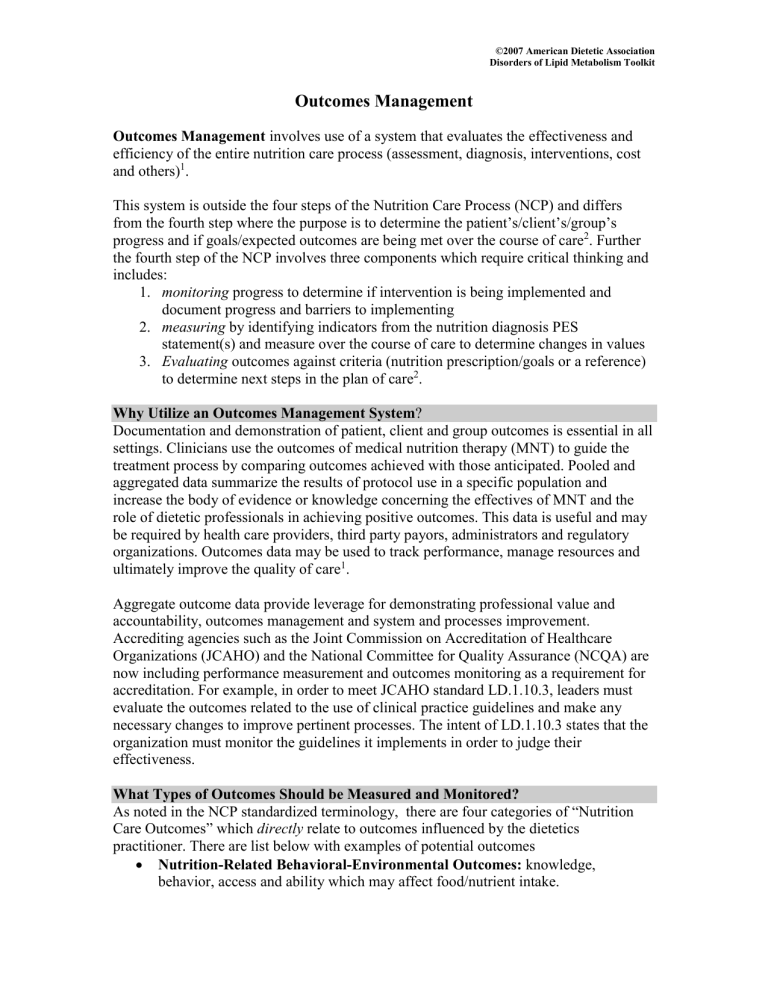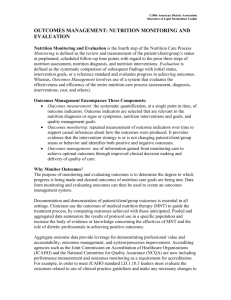OUTCOMES MANAGEMENT: NUTRITION

©2007 American Dietetic Association
Disorders of Lipid Metabolism Toolkit
Outcomes Management
Outcomes Management involves use of a system that evaluates the effectiveness and efficiency of the entire nutrition care process (assessment, diagnosis, interventions, cost and others)
1
.
This system is outside the four steps of the Nutrition Care Process (NCP) and differs from the fourth step where the purpose is to determine the patient’s/client’s/group’s progress and if goals/expected outcomes are being met over the course of care
2
. Further the fourth step of the NCP involves three components which require critical thinking and includes:
1.
monitoring progress to determine if intervention is being implemented and document progress and barriers to implementing
2.
measuring by identifying indicators from the nutrition diagnosis PES statement(s) and measure over the course of care to determine changes in values
3.
Evaluating outcomes against criteria (nutrition prescription/goals or a reference) to determine next steps in the plan of care
2
.
Why Utilize an Outcomes Management System ?
Documentation and demonstration of patient, client and group outcomes is essential in all settings. Clinicians use the outcomes of medical nutrition therapy (MNT) to guide the treatment process by comparing outcomes achieved with those anticipated. Pooled and aggregated data summarize the results of protocol use in a specific population and increase the body of evidence or knowledge concerning the effectives of MNT and the role of dietetic professionals in achieving positive outcomes. This data is useful and may be required by health care providers, third party payors, administrators and regulatory organizations. Outcomes data may be used to track performance, manage resources and ultimately improve the quality of care 1 .
Aggregate outcome data provide leverage for demonstrating professional value and accountability, outcomes management and system and processes improvement.
Accrediting agencies such as the Joint Commission on Accreditation of Healthcare
Organizations (JCAHO) and the National Committee for Quality Assurance (NCQA) are now including performance measurement and outcomes monitoring as a requirement for accreditation. For example, in order to meet JCAHO standard LD.1.10.3, leaders must evaluate the outcomes related to the use of clinical practice guidelines and make any necessary changes to improve pertinent processes. The intent of LD.1.10.3 states that the organization must monitor the guidelines it implements in order to judge their effectiveness.
What Types of Outcomes Should be Measured and Monitored?
As noted in the NCP standardized terminology, there are four categories of “Nutrition
Care Outcomes” which directly relate to outcomes influenced by the dietetics practitioner. There are list below with examples of potential outcomes
Nutrition-Related Behavioral-Environmental Outcomes: knowledge, behavior, access and ability which may affect food/nutrient intake.
©2007 American Dietetic Association
Disorders of Lipid Metabolism Toolkit
Food and Nutrient Intake Outcomes: food/nutrient intake form all sources (e.g. food, beverages, supplements, enteral and parenteral nutrition).
Nutrition-Related Physical Sign/Symptom Outcomes: anthropometric, biochemical, and physical exam parameters.
Nutrition Related Patient/Client-Centered Outcomes: patient’s/client’s perception of his/her nutrition intervention and its impact on life(e.g. nutrition quality of life, satisfaction).
2
Additionally, the dietetics practitioner may indirectly influence other outcomes noted as
“Health Care Outcomes”, which may also be useful for monitoring. These may include: o Health and Disease Outcomes: decreased risk, improvement of disease condition, prevention of adverse event o Cost Outcomes: decreased diagnostic treatment and cots, decreased hospital and outpatient visits o Patient Outcomes: decreased disability, increased quality of life
2
.
Data Collection Using These Tools
Several data collection forms and tools have been developed for an outcomes management system. Potential outcomes related to adult weight management and the recommendations in the Disorders of Lipid Metabolism Evidence-Based Nutrition
Practice Guideline and Disorders of Lipid Metabolism Toolkit have been identified and listed on each worksheet. These outcomes are listed under the four categories of Nutrition
Care Outcomes.
Within the Excel file there are forms to collect data for an individual patient/client over several encounters as well as forms to monitor aggregate or pooled data. There are also completed forms (samples) which are based on the case studies in this toolkit.
Before collecting patient and client data, a signed confidentiality statement, similar to the one included below (see bottom of document), needs to be signed by each individual.
Directions for Using Excel Worksheets
It is recommended that you save an additional copy of the Excel file so that you have the original version prior to inserting data or altering the forms. The forms provided offer several nutrition care outcomes to be monitored. You may adapt these forms to include additional or to exclude various outcomes to meet your facility needs. Below, you will find the basic instructions for entering data into each form. For additional information, select HELP within the Excel file.
The workbook has six sheets:
1.
Individual Outcomes Monitoring Form : monitor data for an individual patient/client over six encounters, the percent change will be calculated
2.
Aggregate Input Form: input and monitor aggregate data, averages will be calculated
3.
Aggregate Outcomes Monitoring Form: pulls data from “Aggregate
Input Form” and calculates percentage change from the first to last encounter, no data is entered in this form
©2007 American Dietetic Association
Disorders of Lipid Metabolism Toolkit
4.
Sample Individual Outcomes Form: illustrates completed Individual
Outcomes Form using case study in this toolkit
5.
Sample Aggregate Input Form: illustrates completed Aggregate Input
Form using case study in this toolkit
6.
Sample Aggregate Outcomes Form: illustrates calculated Aggregate
Outcomes Form using case study in this toolkit
The gray tabs on the bottom let you choose the various sheets. Select a tab and it will change from gray to white. This allows you to enter data into the selected sheet. When there are no data entered, you will see cells that have “#DIV/0!” or “###” This indicates a cell that contains a programmed formula. These have been programmed to automatically calculate information such as percentage change, averages or to carry information over from another sheet within the file. Numerical values will be calculated and replace these symbols, once you have entered your data. Formulas are protected so that you will not delete them by accident. All other cells are unprotected so that you can easily enter data.
Note: to alter formulas or sheet format you may “unprotect” sheets by going to TOOLS and selecting PROTECTION and then UNPROTECT SHEET.
Entering Outcomes Data to the Medical Nutrition Therapy Individual Outcomes
Monitoring Form
Before you enter data on the Individual Outcome sheet, you need to duplicate the sheet one or more times for multiple clients.
To duplicate the Individual Outcomes Monitoring Form: o Go to the sheet labeled Individual Outcomes Monitoring Form by selecting from the tabs at the bottom of the page. You may need to use the arrow keys at the bottom left to view the correct tab. o Select EDIT from the toolbar and then select MOVE OR COPY SHEET. o Check the box labeled CREATE A COPY and then select OK. This will create a copy of the sheet labeled “Individual Outcomes Monitoring Form
(2).” o Continue this process until you have the needed number of forms. o To rename the additional forms, double-click on each tab and type the appropriate label.
Enter individual client information under the appropriate encounter number in order to track progress over time.
Entering Outcomes Data to the Medical Nutrition Therapy Aggregate Input Form
This worksheet is currently set for 10 clients. For additional clients, you will need to add more rows to this sheet by the following steps: o Unprotect this worksheet by going to the toolbar and selecting TOOLS.
Select PROTECTION and then UNPROTECT SHEET.
o Add a row or rows by highlighting row 16, then go to the toolbar and select INSERT and then ROWS. Be sure to add rows within rows 6-16 so that the programmed formulas can average the inserted data.
o Continue this process until you have added the desired number of rows.
©2007 American Dietetic Association
Disorders of Lipid Metabolism Toolkit
Determine the “Encounter” numbers that will be used to track the data for your aggregate population. The first set of data is for the first encounter and you may enter in the designated encounter number for the second set of data (e.g., you may enter data from Encounter 1 and compare this to data from Encounter 4 for this population).
Enter multiple clients in the left column and the client data in the appropriate cells for the determined encounters.
The last row, labeled “Total Average Summary,” will automatically calculate the average of each outcome value for your population.
Data for the Medical Nutrition Therapy Aggregate Outcomes Monitoring Form
You do not need to enter any data into this form. This form pulls data from the
“Aggregate Input Form”. It is for viewing the summary of aggregate data.
The Encounter Number and the Total Average Summary data from the Aggregate
Input Form will automatically populate the cells in the Aggregate Outcomes
Monitoring Form and will calculate the percentage change between the determined encounters for each outcome value in this population.
IMPORTANT! Before you leave a worksheet, go back and protect the worksheet again.
This is your safeguard against deleting formulas. To protect the worksheet:
Go to TOOLS
Select PROTECTION
Select PROTECT SHEET
A box will appear with check marks. Do not change the checkmarks; leave the password blank.
Select OK.
Interpreting the Data from the Programmed Formulas
There are several programmed formulas within the spreadsheets designed to analyze your data without requiring hand calculations.
Medical Nutrition Therapy Individual Outcomes Monitoring Form: You will see a “% change” column, which reports the change from the initial encounter to the most recent encounter for a specific outcome. If there is no data within the column under Encounter
1, the formula will use the data from Column 2 and compare this with the most recent encounter. The percentage change will be a negative number if the value has decreased
(this is usually the desired change) and will be a positive number if the value has increased.
You will also see a column titled “Data Calculation Field” in column Q of the spreadsheet. This column is not reporting any data, but is used as a calculation area and is required for the formulas to work properly. When copying the spreadsheet, this column should be included.
Do not move or delete this calculation field.
Medical Nutrition Therapy Aggregate Input Form: The last row on this worksheet calculates the total average of each outcome measure for all patients entered on the sheet.
©2007 American Dietetic Association
Disorders of Lipid Metabolism Toolkit
You will see the averages of the values from the first encounter and the averages for the last determined encounter. The average values and encounter numbers will be automatically transferred to the Aggregate Outcomes Monitoring Form.
Aggregate Outcomes Monitoring Form:
This form reports the “% change” for the aggregate population from the first determined encounter to the last determined encounter, regarding each outcome measure. The percentage change will be a negative number if the value has decreased (this is usually the desired change) and will be a positive number if the value has increased.
References
1.
Lacey K, Pritchett E. Nutrition care process and model: ADA adopts road map to quality care and outcomes management. J Am Diet Assoc 2003;103:10611072 .
2.
International Dietetics & Nutrition Terminology (IDNT) Reference Manual,
Standardized Language for the Nutrition Care Process.
Chicago, IL: American
Dietetic Association; 2008.
©2007 American Dietetic Association
Disorders of Lipid Metabolism Toolkit
Data Privacy and Security
It is important that a confidentiality statement like the following be attached to all data reports shared at a site. o CONFIDENTIAL: This document has been prepared for review and evaluation by the ______________________ Committee and is entitled to the protection of the peer review, medical review, quality assurance or other similar privileges provided for by state and federal law. It is not to be copied or distributed without the express, written consent of the legal department.
A written patient consent must be obtained before sharing any data. The following is an example informed consent form. o REQUEST & AUTHORIZATION FOR RELEASE OF PATIENT
INFORMATION
I, hereby authorize the release (patient’s name) of all relevant data in my patient records to the …..
I understand that I will receive a copy of this consent form if requested.
Date Client (Parent/Guardian) Signature
Witness Signature Date








